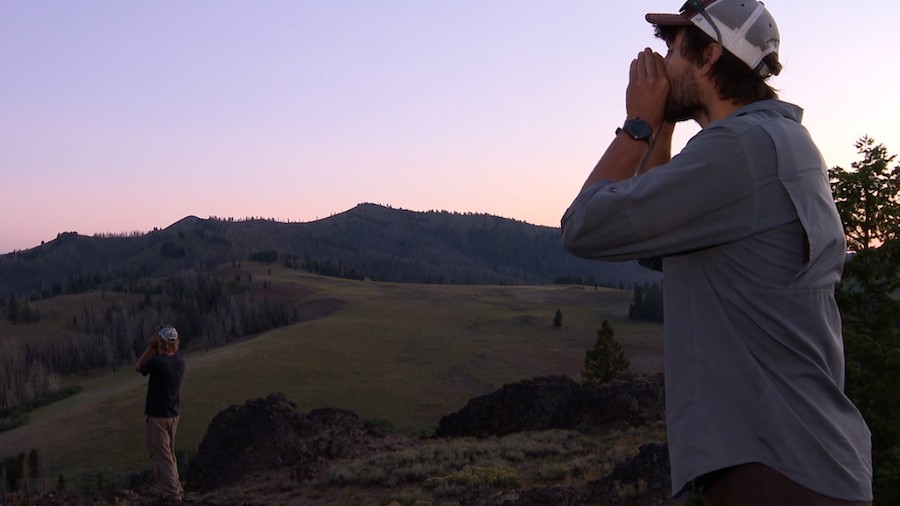A journey through the Idaho backcountry to promote the coexistence of wolves and livestock
Published atWOOD RIVER VALLEY (KIVI) — A Wood River Valley nonprofit is working to extend its outreach and promote the coexistence of livestock and wolves in their area. Their work continues to be conducted while legislation is being passed in Idaho to kill the majority of the state’s wolves.
An average day for Field Manager Logan Miller and Field Tech Nathan Redon begins with a four-mile hike into the backcountry.
As part of the Wood River Wolf Project, they believe that wolves are essential for North American ecosystems and they work to promote the coexistence of livestock and wolves by proactively using nonlethal measures to prevent depredation.
Their journey into the wilderness includes being on the constant lookout for signs of wolf tracks. During their trek on Thursday afternoon, Miller and Redon came across a field with a large number of sheep prints, and about 100 feet from those prints were wolf tracks. Both of those prints led them to believe that the area they were in could potentially be a conflict area, where wolves and sheep are both using the same exact spot.
“Little red riding hood is a story that has been passed down from generation to generation,” said Miller. ”I think we need to distance ourselves from some of those fear-based tactics.”
As part of their research, Miller and Redon stopped to examine one of the cameras they have set up along their hike. The video proves their theory, both wolves and sheep have been using the area.
“Right at the same location as all those sheep, we have got this wolf coming over here and checking out the camera,” said Redon.

As difficult as gathering this data may be, all of it gets shared with local ranchers so they know of possible conflict areas of livestock and wolves. In order to accomplish their goals, they work with five producers in the area and promote the use of non-lethal wolf deterrents such as flashing lights, and loud noises, dogs and human presence.
“In doing so we have been able to create an area where wolves and livestock have been co-existing since our inception,” said Miller. “We have been very successful at keeping sheep loss down as well as the number of wolves that have been killed down.”
RELATED | Bill to kill up to 90% of Idaho wolves heads to governor
The wolf project’s biggest threat currently comes from a bill signed into law by Idaho Governor Brad Little. A measure that could lead to killing 90% of the state’s 1,500 wolves in a move that was backed by hunters and the state’s powerful ranching sector.
“This is the wolves’ home and that has always been the case,” said Miller. “You know they have always been here, and I think we need to learn to deal with that rather than kicking them out again.”
The law also expands the way wolves can be hunted and killed. Those methods include hunting, trapping, and snaring an unlimited number of wolves on a single hunting tag, using night-vision equipment, chasing down wolves on snowmobiles and ATVs, and shooting them from helicopters. Newborn pups can also be killed if they are found on private land.
“You know you are not allowed to hunt elk like that, you should not be able to hunt a wolf-like that,” said Miller.
Not everyone agrees with Miller. Nonprofit Idaho For Wildlife has come out in support of the bill. In a statement provided to Idaho News 6 they said:
“The uninformed claim this is a war on wolves. In reality, It’s not a war on wolves when the goal is to meet predetermined population objectives that were agreed to by federal, state, and environmental groups prior to delisting. Hyperbole is when one uses dramatic claims in order to influence the thoughts and decisions of others, and the ARA’s rely on this underhanded tool regularly.”
“It’s very heartbreaking,” said Miller. “I definitely don’t want to see it, and that is why I’m very glad the community here supports our work and wants to see this project continue and wants to see wolf coexistence occur.”

The final part of Miller and Redon’s trek into the backcountry has them conducting a howling survey while the moon is up.
“We are doing this in order to identify rendezvous sites,” Miller said. “That will let us avoid places where the sheep may be going so, we know where the highest risk areas are.
As odd as it may look, Miller and Redon said when they hear a wolf howl back at them, the feeling is electric.
“It’s a lot of hard work that pays off just in order to get to the point where you have a successful howl.”



